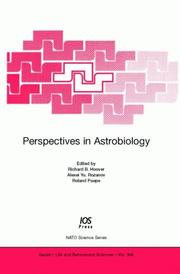| Listing 1 - 4 of 4 |
Sort by
|

ISSN: 15667693 ISBN: 9781586035129 1586035126 Year: 2005 Volume: v. 366 Publisher: Amsterdam : IOS Press,
Abstract | Keywords | Export | Availability | Bookmark
 Loading...
Loading...Choose an application
- Reference Manager
- EndNote
- RefWorks (Direct export to RefWorks)
Astrobiology is the multi-disciplinary field devoted to the investigation of the origin; physical, chemical and environmental limitations; and the distribution in space and time of life on Earth and in the Cosmos. Astrobiology seeks an answer to one of the most fundamental of all questions: - Is Life Restricted to Planet Earth or is Life a Cosmic Imperative? Understanding the characteristics, properties, habits and diversity of living organisms on Earth is crucial to determine where and how to search for evidence of life elsewhere.
Exobiology --- Life on other planets --- Astrobiology --- Extraterrestrial Life --- Life, Extraterrestrial --- Exobiologie --- Vie extraterrestre --- Congresses. --- Congrès --- Extraterrestrial Environment --- Space Biology --- Biologies, Space --- Biology, Space --- Space Biologies --- Space Research
Periodical
ISSN: 1349967X 09149201 Year: 1987 Publisher: Sagamihara, Japan : Japanese Society for Biological Sciences in Space,
Abstract | Keywords | Export | Availability | Bookmark
 Loading...
Loading...Choose an application
- Reference Manager
- EndNote
- RefWorks (Direct export to RefWorks)
Space biology --- Space medicine --- Exobiology --- Space Flight. --- Extraterrestrial Environment. --- Cosmic Radiation. --- Exobiology. --- Space biology. --- Space medicine. --- Life Sciences --- Biology --- Aerospace medicine --- Bioastronautics --- Cosmobiology --- Astrobiology --- Extraterrestrial Life --- Life, Extraterrestrial --- Radiation, Cosmic --- HZE Particles --- Cosmic Radiations --- HZE Particle --- Particle, HZE --- Particles, HZE --- Radiations, Cosmic --- Environment, Extraterrestrial --- Space (Astronomy) --- Environments, Extraterrestrial --- Extraterrestrial Environments --- Spaces (Astronomy) --- Spaceflight --- Space Exploration --- Exploration, Space --- Explorations, Space --- Flight, Space --- Flights, Space --- Space Explorations --- Space Flights --- Spaceflights --- Medicine --- Space sciences --- Transportation medicine --- Aviation medicine --- Habitable planets --- Life --- Extraterrestrial Environment --- Solar Activity --- Space Flight --- Planets --- Space Travel --- Space Travels --- Travel, Space --- Travels, Space --- Aerospace Medicine --- Origin --- Space Biology --- Biologies, Space --- Biology, Space --- Space Biologies --- Space Research
Periodical
Abstract | Keywords | Export | Availability | Bookmark
 Loading...
Loading...Choose an application
- Reference Manager
- EndNote
- RefWorks (Direct export to RefWorks)
Exobiology --- Exobiology. --- Exobiologie --- Vie --- Évolution (Biologie) --- Écologie --- Origines --- Astrobiology --- Extraterrestrial Life --- Life, Extraterrestrial --- Evolution. Phylogeny --- Biology --- Habitable planets --- Life --- Extraterrestrial Environment --- Origin --- Space Biology --- Biologies, Space --- Biology, Space --- Space Biologies --- Space Research --- Evolution (Biology) --- Ecology --- Animal evolution --- Animals --- Biological evolution --- Darwinism --- Evolutionary biology --- Evolutionary science --- Origin of species --- Evolution --- Biological fitness --- Homoplasy --- Natural selection --- Phylogeny --- Philosophy --- Ecology. --- Origin. --- Balance of nature --- Bionomics --- Ecological processes --- Ecological science --- Ecological sciences --- Environment --- Environmental biology --- Oecology --- Environmental sciences --- Population biology --- Abiogenesis --- Biogenesis --- Germ theory --- Heterogenesis --- Life (Biology) --- Life, Origin of --- Origin of life --- Plasmogeny --- Plasmogony --- Spontaneous generation

ISBN: 1280187743 9786610187744 0387218483 0387987010 9780387987019 9780387952895 0387952896 Year: 2000 Publisher: New York : Copernicus,
Abstract | Keywords | Export | Availability | Bookmark
 Loading...
Loading...Choose an application
- Reference Manager
- EndNote
- RefWorks (Direct export to RefWorks)
n November 12, 2002, Dr. John Chambers of the NASA Ames - search Center gave a seminar to the Astrobiology Group at the OUniversity of Washington. The audience of about 100 listened with rapt attention as Chambers described results from a computer study of how planetary systems form. The goal of his research was to answer a dec- tively simple question: How often would newly forming planetary systems produce Earth-like planets, given a star the size of our own sun? By “Ear- like” Chambers meant a rocky planet with water on its surface, orbiting within a star’s “habitable zone. ” This not-too-hot and not-too-cold inner - gion, relatively close to the star, supports the presence of liquid water on a planet surface for hundreds of million of years—the time-span probably n- essary for the evolution of life. To answer the question of just how many Earth-like planets might be spawned in such a planetary system, Chambers had spent thousands of hours running highly sophisticated modeling p- grams through arrays of powerful computers. x Preface to the Paperback Edition The results presented at the meeting were startling. The simulations showed that rocky planets orbiting at the “right” distances from the central star are easily formed, but they can end up with a wide range of water c- tent.
Life on other planets. --- Exobiology. --- Exobiology --- Extraterrestrial Environment. --- Origin of Life. --- Environment, Extraterrestrial --- Space (Astronomy) --- Environments, Extraterrestrial --- Extraterrestrial Environments --- Spaces (Astronomy) --- Space Flight --- Astrobiology --- Extraterrestrial Life --- Life, Extraterrestrial --- Extraterrestrial Environment --- Habitable planets --- Extraterrestrial life --- Fermi's paradox --- Genesis of Life --- Life Geneses --- Life Genesis --- Life Origin --- Life Origins --- Popular works. --- Science. --- Astrobiology. --- Astronomy. --- Popular Science. --- Popular Science in Astronomy. --- Science, general. --- Organelle Biogenesis --- Planets --- Biology --- Life --- Origin --- Life on other planets --- Vie extraterrestre --- Exobiologie --- Science, Humanities and Social Sciences, multidisciplinary. --- Space Biology --- Biologies, Space --- Biology, Space --- Space Biologies --- Space Research --- Origin of Life --- Prebiotic Chemical Evolution --- Chemical Evolution, Prebiotic --- Evolution, Prebiotic Chemical --- Prebiotic Chemical Evolutions
| Listing 1 - 4 of 4 |
Sort by
|

 Search
Search Feedback
Feedback About UniCat
About UniCat  Help
Help News
News